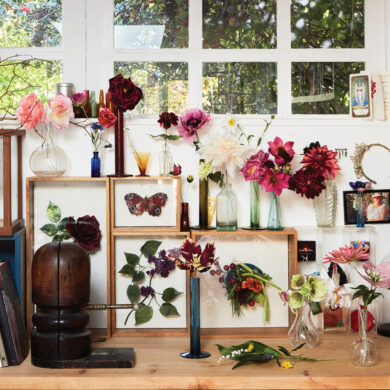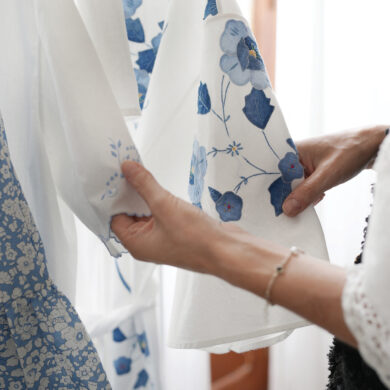For as long as I can remember, I’ve been an artist. My older brother and I were both artists, so it never registered as something unique. In my youth, I was always on a creative conquest, whether it be rearranging my parents’ furniture (“surprise!”), decorating with Puffy Paints, Bedazzling things, bleaching my jeans, attempting to cut/color/straighten my hair, or painting murals on my walls. I was always seeking transformation, a true Scorpio. Being an artist wasn’t a label, it was just how I went through life. Making things and beautifying my world was my happy place. One of the things I loved about art, unlike math, was there were no wrong answers. Only opinions.
I entered high school and became one of the art class stars. In those times, I was really influenced by the illustrations I would see in Seventeen Magazine. I was drawn to a certain color palette, peachy pastels, stark typography. I’ve always loved Little Golden Books with their nostalgic Futura font. Mary Blair became a big hero to me, among other illustrators, such as Maira Kalman.
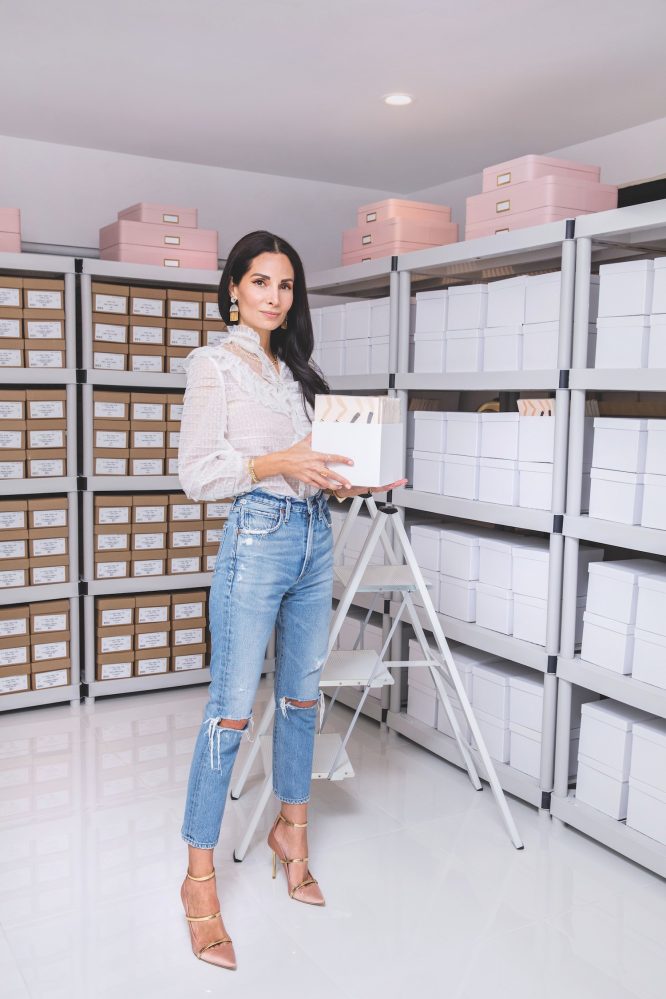
Then one day tragedy struck my family like a bolt of lightning. Halfway through my freshman year, my brother Joseph died in a car accident. He was 17. Just like that, it was no longer two artists, it was just me and a pile of my brother’s sketchbooks, his paint-covered sneakers, his hundreds of magic markers, the artifacts of his life. As one can imagine, it was incomprehensibly devastating. The loss of my only sibling, my mentor, my protagonist, my muse, the person I said “I hate you” to as I flung things at his head. The electric warfare of siblinghood was over in a blink. My loud Italian-American household became deafeningly quiet, especially upstairs where our two bedrooms were located. During those excruciating years, art truly got me through.
We were fortunate to grow up down the street from a world-renowned art school, Rhode Island School of Design. Now that my brother was no longer with me, I pursued RISD with every ounce of my being, for both of us.
I was accepted into RISD, graduated with a BFA in illustration, and subsequently moved to New York City to become an illustrator. I wound up working as a fashion Art Director. With the help of my art rep, I also landed several children’s books with major publishers over those years. It was a dream come true to be a published children’s book illustrator.
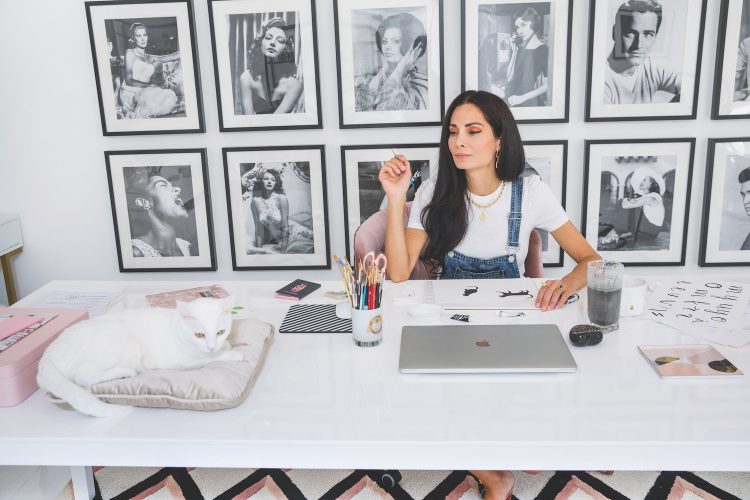
I met the love of my life, David, during that time, and we moved in together. Although he wasn’t an artist, he was creative in his own way, and had big opinions about design. Our first fight was about throw pillows—I made him a collage of 16 pillows I liked, and he told me things just might not work out between us. I won that battle on both fronts, and I now have my own line of pillows.
We went on to live in several different apartments together before getting engaged and moving to Los Angeles for his job. It was really tough to leave behind the place that I loved so much. I did not want to abandon my identity as a New Yorker. I felt lost in Los Angeles. I think LA is a little bit lost itself, and is somewhat meandering and lackadaisical. My discomfort gave way to a hard-hitting realization—that I had been hiding from my illustration career. And I was hiding because it had become a source of pain.
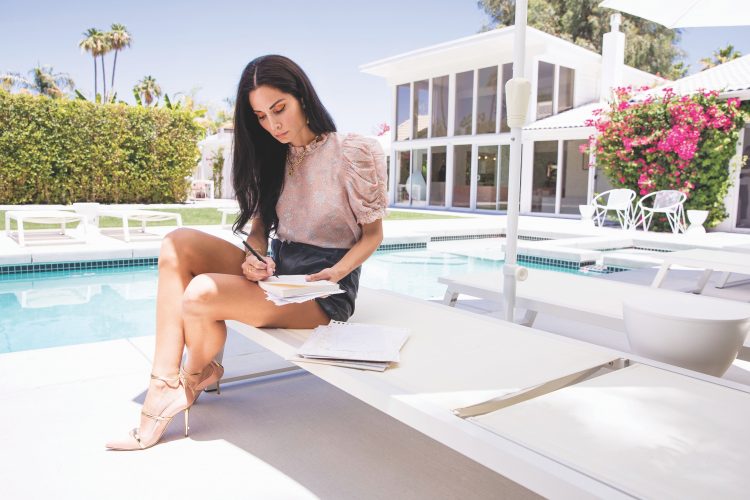
As any artist knows, it’s not all blissful rainbows and puffy clouds all the time. Being an artist is really painful sometimes. The thing that saved me in my youth, also gave me some big wounds.
For every children’s book that gets published, there are ten that are dying softly on an outdated external hard drive in the back of your closet. You never ever forget those ones. One book idea in particular still haunts me—it’s one that got away. It broke my spirit and led me down a long dark road that culminated in me giving up on book illustrating altogether. I had so much fear that the project would get away from me, be watered down during the editing process, and become some different version of itself that I didn’t recognize or care about anymore. So, I just tucked it away—anything to not confront my deepest doubts and fears. But that backfired and I became resentful and no longer inspired. I was tired of the external opinions clouding my creative process.
I just wanted to create for myself, like I did when I was young. I had spent my entire professional life working toward something that I was ready to abandon. During this painful creative lull, I was lamenting my frustrations to a songwriter friend of mine and he gave me a book recommendation, “The War of Art” by Steven Pressfield. That book ended up changing my life. It spoke directly to everything I had been feeling—all the demons, the doubts, and the myriad of emotional daggers that artists face. I no longer felt alone, or even special, for that matter.
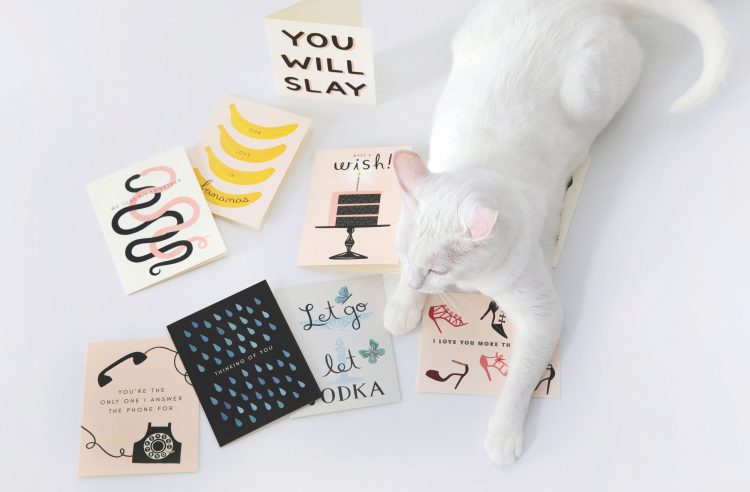
I decided that I would set aside an entire year to create art every day just for the sake of creating, without judgment or an agenda, without deadlines, without editors or critics, and without expectations or a goal in mind. And that’s exactly what I did.
A distinct voice inside told me that I needed to paint. I was being directed away from my typical medium of digital collage, and toward more visceral, tactile methods. I didn’t question it. What was happening felt spiritual. I had to completely rebuild my confidence from the ground up, crash the old pathways, and start anew. I spent hours experimenting with techniques I had not touched since art school, like using gouache paint. I healed and fell in love with art again, whole-heartedly.
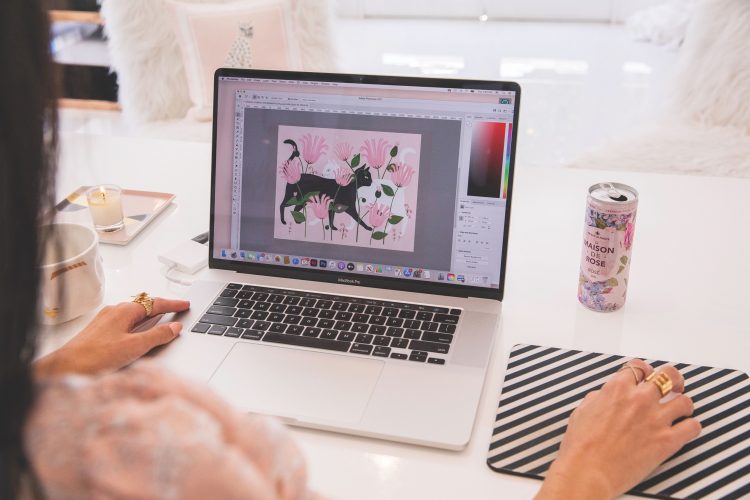
After several months of this new focus, I started to see something cohesive emerge. I noticed that there was a point of view in the art, a voice forming. They were little vignettes with humor and feeling. The artwork lent itself to greeting cards, and it all clicked with my sense of humor (which was always too over-the-top for kids’ books). I couldn’t stop, I wrote hundreds of cards in rapid succession, and it was an exhilarating process. I found my passion, I knew this was my path, and it just felt right.
I had created a line of product for the joy of it, and I loved it. It really didn’t matter to me what happened after that. I wanted commercial success, of course, but I didn’t need it as much as the rediscovery of my creative passion.
My Brand and My Inspiration
As a collage artist, it’s always been just me and an X-acto blade. That’s how the name Girl w/ Knife came to be. The name captures a part of my process and my preferred medium. In addition, it pays homage to my great-grandfather’s knife manufacturing company, Ideal Knife Co. My grandfather inherited that business, and I guess I inherited an affinity for knives. There’s an autobiographical element to almost everything I create. I paint all the things, people, places and animals I love and connect with. I pull ideas from my own life and incorporate those elements into my designs—travel, friends, family, humor, fashion—it’s all in there.
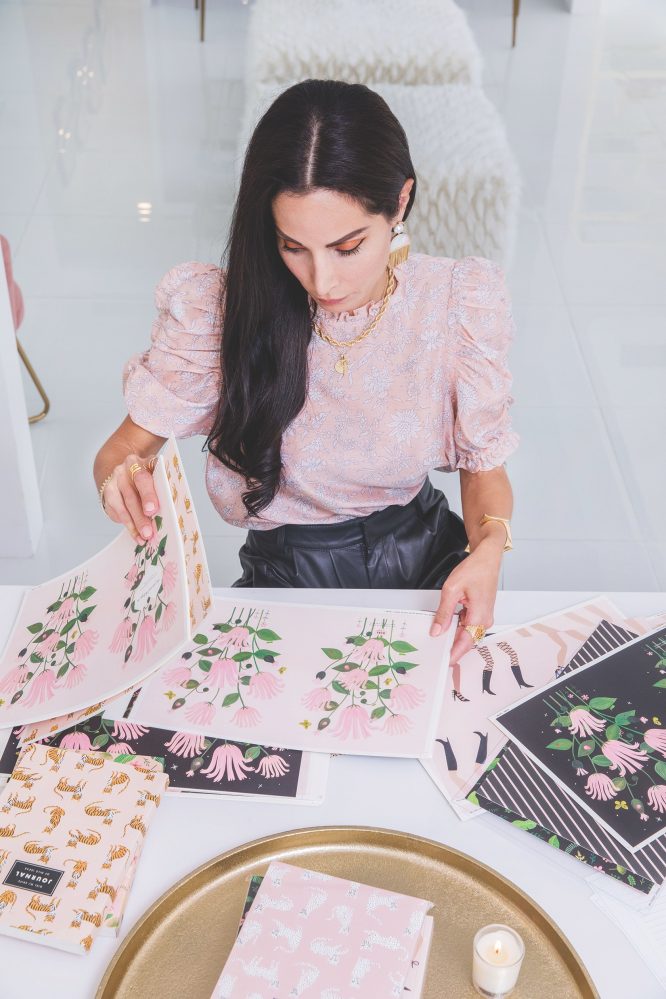
My Workspace – Knife/House
Some people love and play off of chaos, but I need my environment to be in order and beautiful, or I’ll get distracted and derailed. My workspace reflects that beauty, order and continuity in design, pattern and color. I’ve made a decision to have a live/workspace as my primary office so I don’t have to separate the two areas of my life—they are basically one and the same anyway, so why divide the experience into two distinct locations.
What I’m really saying is, why be away from my cat? I’ve created a sanctuary in my home and I want that to serve as an inspirational and creative environment where my team and I can collaborate and take care of business. At present, that space is Knife/House—a gut-renovated mid-century home in the heart of Palm Springs which I built out to incorporate all of the elements of my brand. My throw pillows are on the couches, my art prints are on the walls, and the color patterns throughout mimic my stationery designs. It’s a place to host events, parties, and fashion shoots, to entertain buyers, and, of course, to get work done. Spiritual connection is also important to me. I have a plate of crystals, and other meaningful objects close to me when I work. My father’s ashes are inside a black, heart-shaped stone on my desk. I wear my late brother Joseph’s Playboy bunny necklace charm from the 80’s and my late father’s Italian horn necklace. I regularly talk to both of them—they’re my cheering squad from up above. And perhaps the most important element of the creative process is the presence of my muse—my gorgeous rescue kitty, Princess Vespa. She keeps a watchful eye over my every move. Her official title is Office Manager.
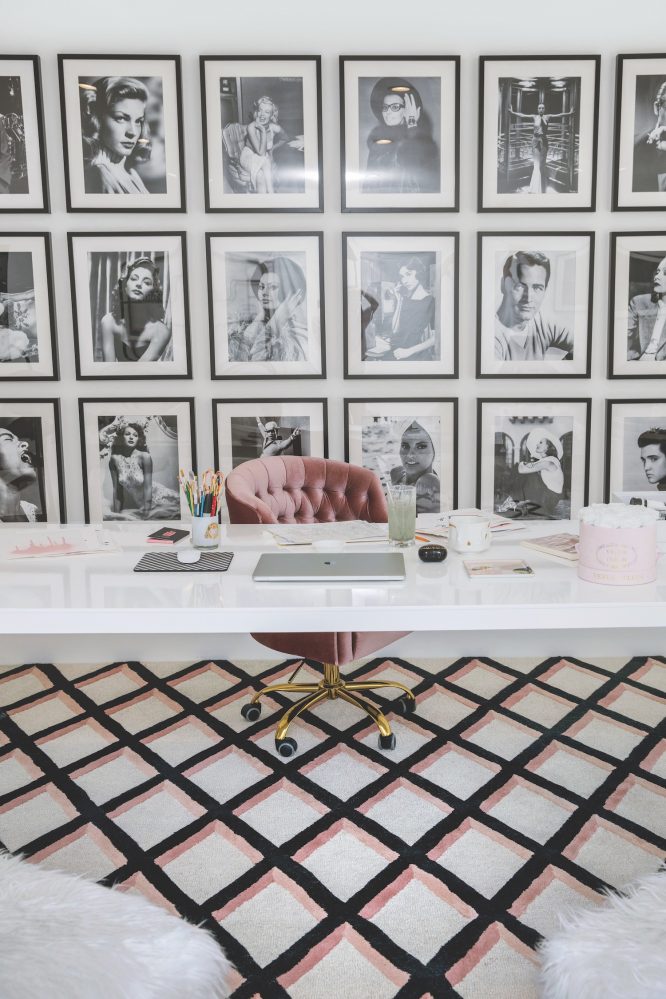
My process for creation of Girl w/ Knife designs is a combination of modalities that gives me flexibility and control of my art (to the extent possible…). I have piles of haphazard sketches and fragments of ideas, some that I can’t even decipher. They’re fluid and conceptual, really more like doodles. Ideas can be so fleeting, so I will write on literally anything in front of me. I keep a pad beside my bed and just outside the shower, because you never know when inspiration will strike. My process these days is a hybrid of collage and painting. Each day I take inventory of all the scraps of ideas in my sketch pile and see what speaks to me as I decide what I feel like painting.
After I paint for the day, I let all of that dry overnight. I’ll then scan it all into my digital library, which is like my right hand. I have several hundreds of scanned paintings. From my library of scans, I might have ten or twelve pages of trees, birds, shoes, or various hand-lettered alphabets. It’s always expanding. I draw upon this library constantly. In addition to the painted elements, I have a separate, massive library of scanned magazine textures and background washes, which I also use in my art.
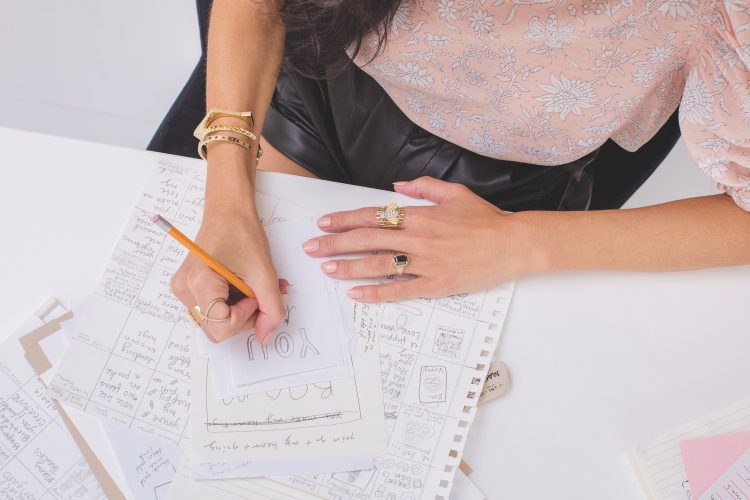
Then begins the collage assembly process. It can be quite simple, or maddeningly intricate, based on what I’m illustrating. For instance, when creating a tropical garden scene for a gift wrap design, there can be a few hundred Photoshop layers. Each leaf, each bug, each flower head, and each stem is on its own layer. There are a ton of moving parts. My preference for this process is rooted in one of those dramatic art school heartbreaks I had at RISD. I was up late working on a piece with gouache paint and accidentally spilled water across it, which ruined the work. I was devastated by the fragility of the process, and started looking at digital illustration as a means to have greater control. There is a sense of peace that comes from the function of the “undo” button. It became my new best friend. I guess you can say I’m a collage commitment-phobe. Why glue something down when you can do it digitally and have the space to change your mind? And I am constantly changing my mind and tweaking things. Over the years, I’ve become a master of Photoshop and InDesign. I love the balance I’ve created between the tactile world of painting and the digital means of assembly. It truly allows me to create with joy and reckless abandon.
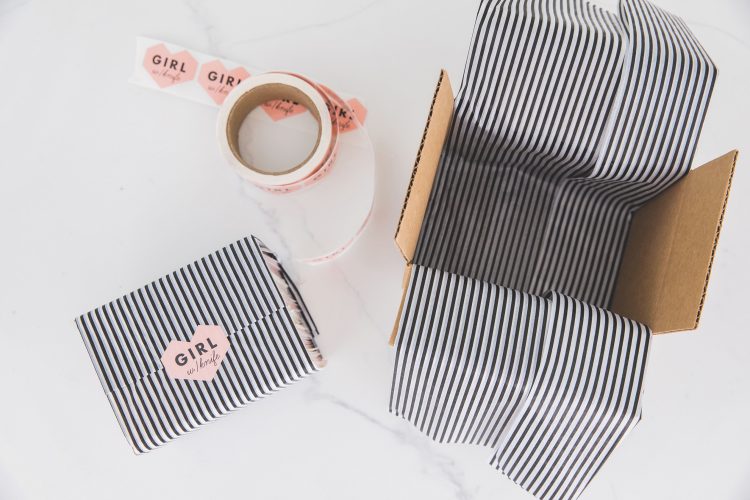
Once the final illustration is complete, I transfer the digital files to my printing house for test copies to proof. I print locally, in Los Angeles, which means I get to be hands-on with the process. Once printed, some product is shipped to me at Knife/House for fulfillment of smaller orders, and some to my warehouse for larger orders that require pallet shipping. The same process is followed for all of my products…everything is carefully crafted, everything is high quality. Opening a box from Girl w/ Knife needs to be a memorable experience.
The older I get, the more I realize what a special path it is to be an artist. In some ways, it’s like never having to grow up. My relationship with my art has been complicated, but I’m grateful for the ride and the lessons. I wish I could tell my 14-year-old self that life would turn out this good.
For as long as I can remember, I’ve been an artist. My older brother and I were both artists, so it never registered as something unique. In my youth, I was always on a creative conquest, whether it be rearranging my parents’ furniture (“surprise!”), decorating with Puffy Paints, Bedazzling things, bleaching my jeans, attempting to cut/color/straighten my hair, or painting murals on my walls. I was always seeking transformation, a true Scorpio. Being an artist wasn’t a label, it was just how I went through life. Making things and beautifying my world was my happy place. One of the things I loved about art, unlike math, was there were no wrong answers. Only opinions.
I entered high school and became one of the art class stars. In those times, I was really influenced by the illustrations I would see in Seventeen Magazine. I was drawn to a certain color palette, peachy pastels, stark typography. I’ve always loved Little Golden Books with their nostalgic Futura font. Mary Blair became a big hero to me, among other illustrators, such as Maira Kalman.

Then one day tragedy struck my family like a bolt of lightning. Halfway through my freshman year, my brother Joseph died in a car accident. He was 17. Just like that, it was no longer two artists, it was just me and a pile of my brother’s sketchbooks, his paint-covered sneakers, his hundreds of magic markers, the artifacts of his life. As one can imagine, it was incomprehensibly devastating. The loss of my only sibling, my mentor, my protagonist, my muse, the person I said “I hate you” to as I flung things at his head. The electric warfare of siblinghood was over in a blink. My loud Italian-American household became deafeningly quiet, especially upstairs where our two bedrooms were located. During those excruciating years, art truly got me through.
We were fortunate to grow up down the street from a world-renowned art school, Rhode Island School of Design. Now that my brother was no longer with me, I pursued RISD with every ounce of my being, for both of us.
I was accepted into RISD, graduated with a BFA in illustration, and subsequently moved to New York City to become an illustrator. I wound up working as a fashion Art Director. With the help of my art rep, I also landed several children’s books with major publishers over those years. It was a dream come true to be a published children’s book illustrator.

I met the love of my life, David, during that time, and we moved in together. Although he wasn’t an artist, he was creative in his own way, and had big opinions about design. Our first fight was about throw pillows—I made him a collage of 16 pillows I liked, and he told me things just might not work out between us. I won that battle on both fronts, and I now have my own line of pillows.
We went on to live in several different apartments together before getting engaged and moving to Los Angeles for his job. It was really tough to leave behind the place that I loved so much. I did not want to abandon my identity as a New Yorker. I felt lost in Los Angeles. I think LA is a little bit lost itself, and is somewhat meandering and lackadaisical. My discomfort gave way to a hard-hitting realization—that I had been hiding from my illustration career. And I was hiding because it had become a source of pain.

As any artist knows, it’s not all blissful rainbows and puffy clouds all the time. Being an artist is really painful sometimes. The thing that saved me in my youth, also gave me some big wounds.
For every children’s book that gets published, there are ten that are dying softly on an outdated external hard drive in the back of your closet. You never ever forget those ones. One book idea in particular still haunts me—it’s one that got away. It broke my spirit and led me down a long dark road that culminated in me giving up on book illustrating altogether. I had so much fear that the project would get away from me, be watered down during the editing process, and become some different version of itself that I didn’t recognize or care about anymore. So, I just tucked it away—anything to not confront my deepest doubts and fears. But that backfired and I became resentful and no longer inspired. I was tired of the external opinions clouding my creative process.
I just wanted to create for myself, like I did when I was young. I had spent my entire professional life working toward something that I was ready to abandon. During this painful creative lull, I was lamenting my frustrations to a songwriter friend of mine and he gave me a book recommendation, “The War of Art” by Steven Pressfield. That book ended up changing my life. It spoke directly to everything I had been feeling—all the demons, the doubts, and the myriad of emotional daggers that artists face. I no longer felt alone, or even special, for that matter.

I decided that I would set aside an entire year to create art every day just for the sake of creating, without judgment or an agenda, without deadlines, without editors or critics, and without expectations or a goal in mind. And that’s exactly what I did.
A distinct voice inside told me that I needed to paint. I was being directed away from my typical medium of digital collage, and toward more visceral, tactile methods. I didn’t question it. What was happening felt spiritual. I had to completely rebuild my confidence from the ground up, crash the old pathways, and start anew. I spent hours experimenting with techniques I had not touched since art school, like using gouache paint. I healed and fell in love with art again, whole-heartedly.

After several months of this new focus, I started to see something cohesive emerge. I noticed that there was a point of view in the art, a voice forming. They were little vignettes with humor and feeling. The artwork lent itself to greeting cards, and it all clicked with my sense of humor (which was always too over-the-top for kids’ books). I couldn’t stop, I wrote hundreds of cards in rapid succession, and it was an exhilarating process. I found my passion, I knew this was my path, and it just felt right.
I had created a line of product for the joy of it, and I loved it. It really didn’t matter to me what happened after that. I wanted commercial success, of course, but I didn’t need it as much as the rediscovery of my creative passion.
My Brand and My Inspiration
As a collage artist, it’s always been just me and an X-acto blade. That’s how the name Girl w/ Knife came to be. The name captures a part of my process and my preferred medium. In addition, it pays homage to my great-grandfather’s knife manufacturing company, Ideal Knife Co. My grandfather inherited that business, and I guess I inherited an affinity for knives. There’s an autobiographical element to almost everything I create. I paint all the things, people, places and animals I love and connect with. I pull ideas from my own life and incorporate those elements into my designs—travel, friends, family, humor, fashion—it’s all in there.

My Workspace – Knife/House
Some people love and play off of chaos, but I need my environment to be in order and beautiful, or I’ll get distracted and derailed. My workspace reflects that beauty, order and continuity in design, pattern and color. I’ve made a decision to have a live/workspace as my primary office so I don’t have to separate the two areas of my life—they are basically one and the same anyway, so why divide the experience into two distinct locations.
What I’m really saying is, why be away from my cat? I’ve created a sanctuary in my home and I want that to serve as an inspirational and creative environment where my team and I can collaborate and take care of business. At present, that space is Knife/House—a gut-renovated mid-century home in the heart of Palm Springs which I built out to incorporate all of the elements of my brand. My throw pillows are on the couches, my art prints are on the walls, and the color patterns throughout mimic my stationery designs. It’s a place to host events, parties, and fashion shoots, to entertain buyers, and, of course, to get work done. Spiritual connection is also important to me. I have a plate of crystals, and other meaningful objects close to me when I work. My father’s ashes are inside a black, heart-shaped stone on my desk. I wear my late brother Joseph’s Playboy bunny necklace charm from the 80’s and my late father’s Italian horn necklace. I regularly talk to both of them—they’re my cheering squad from up above. And perhaps the most important element of the creative process is the presence of my muse—my gorgeous rescue kitty, Princess Vespa. She keeps a watchful eye over my every move. Her official title is Office Manager.

My process for creation of Girl w/ Knife designs is a combination of modalities that gives me flexibility and control of my art (to the extent possible…). I have piles of haphazard sketches and fragments of ideas, some that I can’t even decipher. They’re fluid and conceptual, really more like doodles. Ideas can be so fleeting, so I will write on literally anything in front of me. I keep a pad beside my bed and just outside the shower, because you never know when inspiration will strike. My process these days is a hybrid of collage and painting. Each day I take inventory of all the scraps of ideas in my sketch pile and see what speaks to me as I decide what I feel like painting.
After I paint for the day, I let all of that dry overnight. I’ll then scan it all into my digital library, which is like my right hand. I have several hundreds of scanned paintings. From my library of scans, I might have ten or twelve pages of trees, birds, shoes, or various hand-lettered alphabets. It’s always expanding. I draw upon this library constantly. In addition to the painted elements, I have a separate, massive library of scanned magazine textures and background washes, which I also use in my art.

Then begins the collage assembly process. It can be quite simple, or maddeningly intricate, based on what I’m illustrating. For instance, when creating a tropical garden scene for a gift wrap design, there can be a few hundred Photoshop layers. Each leaf, each bug, each flower head, and each stem is on its own layer. There are a ton of moving parts. My preference for this process is rooted in one of those dramatic art school heartbreaks I had at RISD. I was up late working on a piece with gouache paint and accidentally spilled water across it, which ruined the work. I was devastated by the fragility of the process, and started looking at digital illustration as a means to have greater control. There is a sense of peace that comes from the function of the “undo” button. It became my new best friend. I guess you can say I’m a collage commitment-phobe. Why glue something down when you can do it digitally and have the space to change your mind? And I am constantly changing my mind and tweaking things. Over the years, I’ve become a master of Photoshop and InDesign. I love the balance I’ve created between the tactile world of painting and the digital means of assembly. It truly allows me to create with joy and reckless abandon.

Once the final illustration is complete, I transfer the digital files to my printing house for test copies to proof. I print locally, in Los Angeles, which means I get to be hands-on with the process. Once printed, some product is shipped to me at Knife/House for fulfillment of smaller orders, and some to my warehouse for larger orders that require pallet shipping. The same process is followed for all of my products…everything is carefully crafted, everything is high quality. Opening a box from Girl w/ Knife needs to be a memorable experience.
The older I get, the more I realize what a special path it is to be an artist. In some ways, it’s like never having to grow up. My relationship with my art has been complicated, but I’m grateful for the ride and the lessons. I wish I could tell my 14-year-old self that life would turn out this good.











